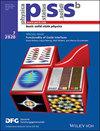有序 Mo2TiAlC2 MAX 和 Mo2TiC2 MXene 中碳 K 边缘能量损失近边缘结构光谱的理论研究
IF 1.8
4区 物理与天体物理
Q3 PHYSICS, CONDENSED MATTER
引用次数: 0
摘要
通过密度泛函理论,研究了取向无关条件下 Mo2TiAlC2 和相应 MoTiC2 Mxene 碳 K 边的能量损失近边结构(ELNES)。与 MAX 相(M 为过渡金属,A 为 13-16 族中的一个元素,X 为 C 或 N)相比,由于结构的变化和键长的减少,Mo2TiC2 MXene 的 C K 边主要光谱特征之间的能级差距增大。这两种体系中 C K 边缘的分散与 p 对称态密度相似。研究表明,这两种物相中 C 1s 边缘第一个精细结构的来源主要是电子转移到 px + py 样性。其他精细结构来自 pz 和 px + py 状态的杂化转变,其中 px + py 样性的贡献突出。此外,通过比较三种钼基化合物的 C K 边 ELNES 光谱发现,在从 Mo2TiAlC2 到 Mo2TiC2 再到 Mo2C 的过程中,由于量子约束效应和激发碳周围化学环境的变化,精细结构的能量位置向更高能量移动(蓝移)。本文章由计算机程序翻译,如有差异,请以英文原文为准。
Theoretical Study of Carbon K‐Edge Energy‐Loss Near‐Edge Structure Spectra in the Ordered Mo2TiAlC2 MAX and Mo2TiC2 MXene
By means of density functional theory, the energy‐loss near‐edge structure (ELNES) of carbon K‐edge of Mo2TiAlC2 and corresponding MoTiC2 Mxene at orientational‐independent condition is dealt with. Compared to the MAX (M is transition metal, A is an elment from group 13–16, X is C or N) phase, the energy separations increase between the main spectral features at the C K edge of Mo2 TiC2 MXene owing to the structural change and decreased bond length. The dispersions of the C K edge in both systems are similar to p‐symmetry densities of states. It is indicated that the source of the first fine structure at the C 1s edge in both phases mainly comes from the electron transfer to p x p y p z p x p y p x p y 2 TiAlC2 to Mo2 TiC2 and then to Mo2 C, the energy position of the fine structures is shifted to higher energies (blueshifted), due to the quantum confinement effects and the change of the chemical environment around the excited carbon.
求助全文
通过发布文献求助,成功后即可免费获取论文全文。
去求助
来源期刊
CiteScore
3.30
自引率
6.20%
发文量
321
审稿时长
2 months
期刊介绍:
physica status solidi is devoted to the thorough peer review and the rapid publication of new and important results in all fields of solid state and materials physics, from basic science to applications and devices. Being among the largest and most important international publications, the pss journals publish review articles, letters and original work as well as special issues and conference contributions.
physica status solidi b – basic solid state physics is devoted to topics such as theoretical and experimental investigations of the atomistic and electronic structure of solids in general, phase transitions, electronic and optical properties of low-dimensional, nano-scale, strongly correlated, or disordered systems, superconductivity, magnetism, ferroelectricity etc.

 求助内容:
求助内容: 应助结果提醒方式:
应助结果提醒方式:


